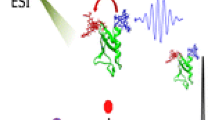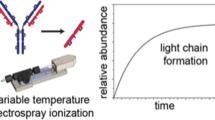Abstract
We have developed a method to determine apparent activation energies of dissociation for ionized protein–protein complexes in the gas phase using electrospray ionization mass spectrometry following the Rice-Ramsperger-Kassel-Marcus quasi-equilibrium theory. Protein–protein complexes were formed in solution, transferred into the gas phase, and separated from excess free protein by ion mobility filtering. Afterwards, complex disassembly was initiated by collision-induced dissociation with step-wise increasing energies. Relative intensities of ion signals were used to calculate apparent activation energies of dissociation in the gas phase by applying linear free energy relations. The method was developed using streptavidin tetramers. Experimentally determined apparent gas-phase activation energies for dissociation (\( {E}_{A\ m0g}^{\#} \)) of complexes consisting of Fc parts from immunoglobulins (IgG-Fc) and three closely related protein G' variants (IgG-Fc•protein G'e, IgG-Fc•protein G'f, and IgG-Fc•protein G'g) show the same order of stabilities as can be inferred from their in-solution binding constants. Differences in stabilities between the protein–protein complexes correspond to single amino acid residue exchanges in the IgG-binding regions of the protein G' variants.

Electrospray mass spectrometry and collision-induced dissociation delivers apparent activation energies and supramolecular bond force constants of protein-protein complexes in the gas phase.





Similar content being viewed by others
Abbreviations
- ESI:
-
electrospray ionization
- \( {E}_{A\ m0g}^{\#} \) :
-
EA: energy of activation, #: apparent (with merged temperature term), m: mean of charge states, 0: at Ecom = 0 eV, g: gas phase
- Fc part:
-
fragment crystallizable part
- IgG:
-
immunoglobulin G
- IVIG:
-
intravenous immunoglobulin
- KD s :
-
dissociation constant in solution
- \( {K}_{D\ m0g}^{\#} \) :
-
KD: dissociation constant, #: apparent (with merged temperature term), m: mean of charge states, 0: at Ecom = 0 eV, g: gas phase
- LFE:
-
linear free energy
- Protein G′:
-
protein G prime
- Protein G′e:
-
protein G prime e (extended)
- Protein G′f:
-
protein G prime f
- Protein G′g:
-
protein G prime g
- ToF:
-
time of flight
- ΔG s :
-
Gibbs free energy difference in solution
References
Przybylski M, Glocker MO. Electrospray mass spectrometry of biomacromolecular complexes with noncovalent interactions—new analytical perspectives for supramolecular chemistry and molecular recognition processes. Angew Chem Int Ed. 1996;35(8):807–26. https://doi.org/10.1002/anie.199608061.
Loo JA. Studying noncovalent protein complexes by electrospray ionization mass spectrometry. Mass Spectrom Rev. 1997;16(1):1–23. https://doi.org/10.1002/(SICI)1098-2787(1997)16.
Pagel K, Natan E, Hall Z, Fersht AR, Robinson CV. Intrinsically disordered p53 and its complexes populate compact conformations in the gas phase. Angew Chem Int Ed. 2013;52(1):361–5. https://doi.org/10.1002/anie.201203047.
Bornschein RE, Ruotolo BT. Ion mobility-mass spectrometry of charge-reduced protein complexes reveals general trends in the collisional ejection of compact subunits. Analyst. 2015;14(20):7020–9. https://doi.org/10.1039/c5an01242b.
Chen F, Gulbakan B, Weidmann S, Fagerer SR, Ibanez AJ, Zenobi R. Applying mass spectrometry to study non-covalent biomolecule complexes. Mass Spectrom Rev. 2016;35(1):48–70. https://doi.org/10.1002/mas.21462.
Hoaglund CS, Valentine SJ, Sporleder CR, Reilly JP, Clemmer DE. Three-dimensional ion mobility/TOFMS analysis of electrosprayed biomolecules. Anal Chem. 1998;70(11):2236–42. https://doi.org/10.1021/ac980059c.
Konijnenberg A, Butterer A, Sobott F. Native ion mobility-mass spectrometry and related methods in structural biology. Biochim Biophys Acta. 2013;1834(6):1239–56. https://doi.org/10.1016/j.bbapap.2012.11.013.
Sobott F, Benesch JL, Vierling E, Robinson CV. Subunit exchange of multimeric protein complexes. Real-time monitoring of subunit exchange between small heat shock proteins by using electrospray mass spectrometry. J Biol Chem. 2002;277(41):38921–9. https://doi.org/10.1074/jbc.M206060200.
Zhong YY, Hyung SJ, Ruotolo BT. Ion mobility-mass spectrometry for structural proteomics. Expert Rev Proteomics. 2012;9(1):47–58. https://doi.org/10.1586/Epr.11.75.
Cooper A (1999) Thermodynamic analysis of biomolecular interactions. Curr Opin Chem biol 3 (5):557-563. https://doi.org/10.1016/S1367-5931(99)00008-3.
Robertson AD, Murphy KP. Protein structure and the energetics of protein stability. Chem Rev. 1997;97(5):1251–67. https://doi.org/10.1021/Cr960383c.
Erba EB, Barylyuk K, Yang Y, Zenobi R. Quantifying protein-protein interactions within noncovalent complexes using electrospray ionization mass spectrometry. Anal Chem. 2011;83(24):9251–9. https://doi.org/10.1021/ac201576e.
Jorgensen TJD, Roepstorff P, Heck AJR. Direct determination of solution binding constants for noncovalent complexes between bacterial cell wall peptide analogues and vancomycin group antibiotics by electrospray ionization mass spectrometry. Anal Chem. 1998;70(20):4427–32. https://doi.org/10.1021/Ac980563h.
Krishnaswamy SR, Williams ER, Kirsch JF. Free energies of protein-protein association determined by electrospray ionization mass spectrometry correlate accurately with values obtained by solution methods. Prot Sci. 2006;15(6):1465–75. https://doi.org/10.1110/ps.062083406.
West GM, Tang L, Fitzgerald MC. Thermodynamic analysis of protein stability and ligand binding using a chemical modification- and mass-spectrometry based strategy. Anal Chem. 2008;80(11):4175–85. https://doi.org/10.1021/ac702610a.
Cech NB, Enke CG. Practical implications of some recent studies in electrospray ionization fundamentals. Mass Spectrom Rev. 2001;20(6):362–87. https://doi.org/10.1002/mas.10008.
Sinelnikov I, Kitova EN, Klassen JS. Influence of Coulombic repulsion on the dissociation pathways and energetics of multiprotein complexes in the gas phase. J Am Soc Mass Spectrom. 2007;18(4):617–31. https://doi.org/10.1016/j.jasms.2006.11.006.
Catalina MI, de Mol NJ, Fischer MJE, Heck AJR. Probing factors affecting the gas phase stabilities of noncovalent complexes formed by peptides bound to the Grb2 SH2 domain protein. Phys Chem Chem Phys. 2004;6(10):2572–9. https://doi.org/10.1039/b315435a.
Baer T, Mayer PM. Statistical Rice-Ramsperger-Kassel-Marcus quasiequilibrium theory calculations in mass spectrometry. J Am Soc Mass Spectrom. 1997;8(2):103–15. https://doi.org/10.1016/S1044-0305(96)00212-7.
Rosenstock HM, Wallenstein MB, Wahrhaftig AL, Eyring H. Absolute rate theory for isolated systems and the mass spectra of polyatomic molecules. Proc Natl Acad Sci U S A. 1952;38(8):667–78. https://doi.org/10.1073/pnas.38.8.667.
Vekey K. Internal energy effects in mass spectrometry. J Mass Spectrom. 1996;31(5):445–63. https://doi.org/10.1002/(Sici)1096-9888(199605)31:5<445::Aid-Jms354>3.0.Co;2-G.
Yefremova Y, Al-Majdoub M, Opuni KFM, Koy C, Yan Y, Gross ML, et al. A dynamic model of pH-induced protein G' e higher order structure changes derived from mass spectrometric analyses. Anal Chem. 2016;88(1):890–7. https://doi.org/10.1021/acs.analchem.5b03536.
Sauer-Eriksson AE, Kleywegt GJ, Uhlen M, Jones TA. Crystal structure of the C2 fragment of streptococcal protein G in complex with the Fc domain of human IgG. Structure. 1995;3(3):265–78. https://doi.org/10.1016/S0969-2126(01)00157-5.
Gulich S, Linhult M, Stahl S, Hober S. Engineering streptococcal protein G for increased alkaline stability. Protein Eng. 2002;15(10):835–42. https://doi.org/10.1093/protein/15.10.835.
Yefremova Y, Al-Majdoub M, Opuni KFM, Koy C, Cui WD, Yan YT, et al. "De-novo" amino acid sequence elucidation of protein G'e by combined "top-down" and "bottom-up" mass spectrometry. J Am Soc Mass Spectrom. 2015;26(3):482–92. https://doi.org/10.1007/s13361-014-1053-2.
Nesatyy VJ. Gas-phase binding of non-covalent protein complexes between bovine pancreatic trypsin inhibitor and its target enzymes studied by electrospray ionization tandem mass spectrometry. J Mass Spectrom. 2001;36:950–9. https://doi.org/10.1002/jms.199.
Nesatyy VJ. Mass spectrometry evaluation of the solution and gas-phase binding properties of noncovalent protein complexes. Int J Mass Spectrom. 2002;221:147–61. https://doi.org/10.1016/S1387-3806(02)00956-9.
Pace CN, Shaw KL. Linear extrapolation method of analyzing solvent denaturation curves. Proteins Suppl. 2000;4:1–7. https://doi.org/10.1002/1097-0134(2000)41:4+3.3.
Bolen DW, Santoro MM. Unfolding free energy changes determined by the linear extrapolation method. 2. Incorporation of delta G degrees N-U values in a thermodynamic cycle. Biochemistry. 1988;27(21):8069–74. https://doi.org/10.1021/bi00421a014.
Yefremova Y, Danquah BD, Opuni KFM, El-Kased RF, Koy C, Glocker MO (2017) Mass spectrometric characterization of protein structures and protein complexes in condensed and gas phase. Eur J Mass Spectrom 23. https://doi.org/10.1177/1469066717722256.
Harvey SR, Yan J, Brown JM, Hoyes E, Wysocki VH. Extended gas-phase trapping followed by surface-induced dissociation of noncovalent protein complexes. Anal Chem. 2016;88:1218–21. https://doi.org/10.1021/acs.analchem.5b03479.
Quintyn RS, Zhou MW, Yan J, Wysocki VH. Surface-induced dissociation mass spectra as a tool for distinguishing different structural forms of gas-phase multimeric protein complexes. Anal Chem. 2015;87:11879–86. https://doi.org/10.1021/ar400223t.
Zhou M, Dagan S, Wysocki VH. Protein subunits released by surface collisions of noncovalent complexes: native-like compact structures revealed by ion mobility mass spectrometry. Angew Chem Int Ed Engl. 2012;51:4336–9. https://doi.org/10.1002/anie.201108700.
Myers JK, Pace CN, Scholtz JM. Denaturant m values and heat capacity changes: relation to changes in accessible surface areas of protein unfolding. Protein Sci. 1995;4(10):2138–48. https://doi.org/10.1002/pro.5560041020.
Pace CN. Determination and analysis of urea and guanidine hydrochloride denaturation curves. Methods Enzymol. 1986;131:266–80. https://doi.org/10.1016/0076-6879(86)31045-0.
Drahos L, Vekey K. Entropy evaluation using the kinetic method: is it feasible? J Mass Spectrom. 2003;38(10):1025–42. https://doi.org/10.1002/jms.538.
Wu L, Lemr K, Aggerholm T, Cooks RG. Recognition and quantification of binary and ternary mixtures of isomeric peptides by the kinetic method: metal ion and ligand effects on the dissociation of metal-bound complexes. J Am Soc Mass Spectrom. 2003;14(2):152–60. https://doi.org/10.1016/S1044-0305(02)00868-1.
Parker MJ, Spencer J, Clarke AR. An integrated kinetic analysis of intermediates and transition states in protein folding reactions. J Mol Biol. 1995;253(5):771–86. https://doi.org/10.1006/jmbi.1995.0590.
Staniforth RA, Burston SG, Smith CJ, Jackson GS, Badcoe IG, Atkinson T, et al. The energetics and cooperativity of protein folding: a simple experimental analysis based upon the solvation of internal residues. Biochemistry. 1993;32(15):3842–51. https://doi.org/10.1021/bi00066a003.
Benesch JL, Ruotolo BT, Simmons DA, Robinson CV. Protein complexes in the gas phase: technology for structural genomics and proteomics. Chem Rev. 2007;107(8):3544–67. https://doi.org/10.1021/cr068289b.
Jurchen JC, Williams ER. Origin of asymmetric charge partitioning in the dissociation of gas-phase protein homodimers. J Am Chem Soc. 2003;125(9):2817–26. https://doi.org/10.1021/ja0211508.
Sciuto SV, Liu JJ, Konermann L. An electrostatic charge partitioning model for the dissociation of protein complexes in the gas phase. J Am Soc Mass Spectrom. 2011;22(10):1679–89. https://doi.org/10.1007/s13361-011-0205-x.
Sobott F, Robinson CV. Characterising electrosprayed biomolecules using tandem-MS—the noncovalent GroEL chaperonin assembly. Int J Mass Spectrom. 2004;236(1–3):25–32. https://doi.org/10.1016/j.ijms.2004.05.010.
Benesch JL. Collisional activation of protein complexes: picking up the pieces. J Am Soc Mass Spectrom. 2009;20(3):341–8. https://doi.org/10.1016/j.jasms.2008.11.014.
Dragusanu M, Petre BA, Slamnoiu S, Vlad C, Tu TT, Przybylski M. On-line bioaffinity-electrospray mass spectrometry for simultaneous detection, identification, and quantification of protein-ligand interactions. J Am Soc Mass Spectrom. 2010;21(10):1643–8. https://doi.org/10.1016/j.jasms.2010.06.011.
Gronewold TMA. Surface acoustic wave sensors in the bioanalytical field: recent trends and challenges. Anal Chim Acta. 2007;603(2):119–28. https://doi.org/10.1016/j.aca.2007.09.056.
Thomas PD, Kejariwal A. Coding single-nucleotide polymorphisms associated with complex vs. Mendelian disease: evolutionary evidence for differences in molecular effects. Proc Natl Acad Sci U S A. 2004;101(43):15398–403. https://doi.org/10.1073/pnas.0404380101.
Zhao N, Han JG, Shyu CR, Korkin D. Determining effects of non-synonymous SNPs on protein-protein interactions using supervised and semi-supervised learning. PLoS Comput Biol. 2014;10(5). ARTN):e1003592. https://doi.org/10.1371/journal.pcbi.1003592.
Stunnenberg HG, Hubner NC. Genomics meets proteomics: identifying the culprits in disease. Hum Genet. 2014;133(6):689–700. https://doi.org/10.1007/s00439-013-1376-2.
David A, Razali R, Wass MN, Sternberg MJ. Protein-protein interaction sites are hot spots for disease-associated nonsynonymous SNPs. Hum Mutat. 2012;33(2):359–63. https://doi.org/10.1002/humu.21656.
Back AL, Kwok WW, Hickstein DD. Identification of two molecular defects in a child with leukocyte adherence deficiency. J Biol Chem. 1992;267(8):5482–7.
Ohashi Y, Yambe T, Tsuchiya S, Kikuchi H, Konno T. Familial genetic-defect in a case of leukocyte adhesion deficiency. Hum Mutat. 1993;2(6):458–67. https://doi.org/10.1002/humu.1380020606.
Etzioni A. Adhesion molecules—their role in health and disease. Pediatr Res. 1996;39(2):191–8. https://doi.org/10.1203/00006450-199602000-00001.
Acknowledgements
We express our thanks to Dr. Stephan Mikkat for providing expertise on mass spectrometry and to Ms Ursula Glocker for preliminary technical assistance. We also thank Dr. Marcus Frank for providing access to the capillary sputter. We acknowledge the German Academic Exchange Service (DAAD) for providing scholarships for YY (no. 91523785), BD (no. 91566064), and KO (no. 91548123). The WATERS Synapt G2S mass spectrometer has been bought through an EU grant (EFRE-UHROM 9) made available to MOG.
Author information
Authors and Affiliations
Corresponding author
Ethics declarations
Conflict of interest
The authors have no conflict of interest to declare.
Electronic supplementary material
ESM 1
(PDF 950 kb)
Rights and permissions
About this article
Cite this article
Yefremova, Y., Melder, F.T.I., Danquah, B.D. et al. Apparent activation energies of protein–protein complex dissociation in the gas–phase determined by electrospray mass spectrometry. Anal Bioanal Chem 409, 6549–6558 (2017). https://doi.org/10.1007/s00216-017-0603-4
Received:
Revised:
Accepted:
Published:
Issue Date:
DOI: https://doi.org/10.1007/s00216-017-0603-4




